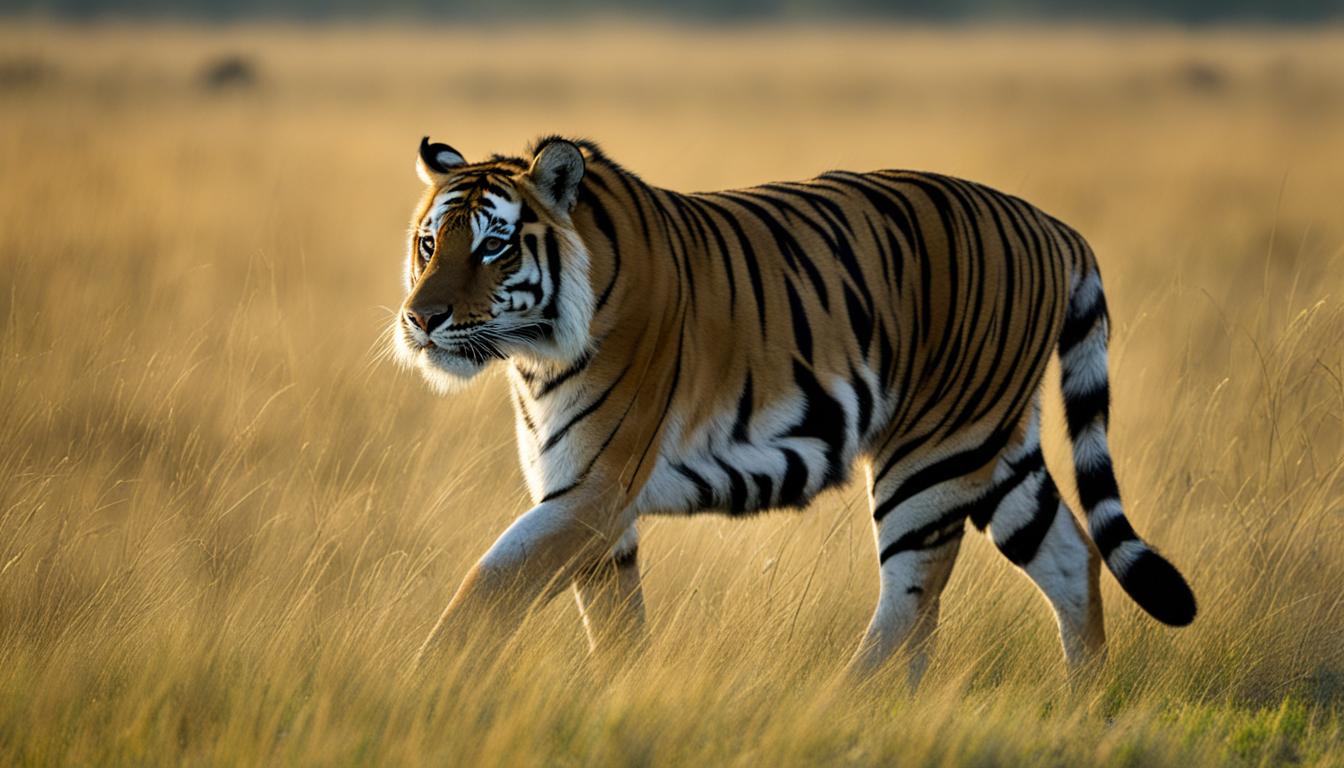Tigers, as one of the largest predators in the world, have a diverse diet consisting primarily of ungulates. They are skilled hunters, employing various techniques and behaviors to secure their prey. Understanding the prey animals of tigers is crucial in comprehending their hunting patterns, interactions, and their role in the food chain.
Key Takeaways:
- Tigers prey on ungulates such as bantengs, sambar, muntjac, gaur, and wild pig.
- Tigers primarily hunt alone, usually at night or dawn.
- Their hunting behavior involves grabbing and biting their prey on the neck.
- Tiger cubs stay with their mother for about two years before establishing their own territories.
- Understanding the prey animals of tigers helps in comprehending their hunting patterns, interactions, and role in the food chain.
Tiger’s Habitat and Ecosystem
Tigers inhabit a variety of natural habitats, from the temperate forests of Siberia to the subtropical and tropical forests found in the Indian subcontinent, Indochina, and Sumatra. These habitats provide the necessary resources for tigers to thrive, including suitable prey and cover for hunting. Tigers play a crucial role in their ecosystems as top predators, influencing the population dynamics of their prey species and contributing to the overall balance of the food chain.
Tigers have their own territories, with males typically having larger home range sizes than females. These territories are essential for providing sufficient space and resources for tigers to survive and reproduce. By having stable territories, tigers can avoid unnecessary competition for resources and maintain a stable population size within their respective areas.
Within their habitats, tigers interact with a diverse range of species through predator-prey relationships. Tigers primarily prey on ungulates, such as bantengs, sambar, muntjac, gaur, and wild pig. These interactions create a complex web of predator-prey dynamics, influencing population sizes, distribution patterns, and behaviors of both tigers and their prey.
Tiger’s Role in the Food Chain
Tigers are apex predators, meaning they are at the top of the food chain in their ecosystems. As such, they have a significant impact on the populations of their prey species, helping to regulate their numbers and prevent overpopulation. This, in turn, has cascading effects on other species within the ecosystem.
| Tiger’s Prey Animals | Hunting Behavior |
|---|---|
| Bantengs | Grab and bite on the neck |
| Sambar | Grab and bite on the neck |
| Muntjac | Grab and bite on the neck |
| Gaur | Grab and bite on the neck |
| Wild pig | Grab and bite on the neck |
Table: Tiger’s Prey Animals and Hunting Behavior
By regulating the population sizes of their prey, tigers help maintain the overall health of the ecosystem. This is because the abundance or scarcity of certain prey species can have a domino effect on other organisms within the food chain. For example, if the tiger population declines and their prey species increase in numbers, it can lead to overgrazing of vegetation, reducing habitat quality for other herbivores and impacting the availability of resources for other predators.
Understanding and protecting the natural habitat of tigers is essential for ensuring their survival and the overall health of their ecosystems. It requires efforts to conserve and restore key habitats, promote sustainable land-use practices, and mitigate human-wildlife conflicts. Only through these collaborative efforts can we secure a future where tigers continue to play their vital role as apex predators and guardians of biodiversity.
Tiger’s Subspecies
There are eight recognized subspecies of tigers, three of which are extinct. The surviving subspecies include the Bengal tiger, Siberian tiger, South China tiger, Sumatran tiger, and Indo-Chinese tiger. Each subspecies has its own unique characteristics, such as size, coat color, and habitat preference.
The Bengal tiger, known as Panthera tigris tigris, is the second-largest subspecies and is found in India, Nepal, Bhutan, Bangladesh, and Myanmar. It has a vibrant coat color with dark stripes and is well-adapted to living in grasslands, forests, and mangrove swamps.
The Siberian tiger, also called Panthera tigris altaica, is the largest subspecies and is found in the Russian Far East and Northeast China. It has a thick coat to withstand the cold climate and is known for its impressive size and strength.
Bengal Tiger vs. Siberian Tiger Comparison
| Subspecies | Bengal Tiger | Siberian Tiger |
|---|---|---|
| Scientific Name | Panthera tigris tigris | Panthera tigris altaica |
| Habitat | India, Nepal, Bhutan, Bangladesh, Myanmar | Russian Far East, Northeast China |
| Coat Color | Orange with dark stripes | Lighter orange with fewer and wider stripes |
| Size | Male: up to 10 feet in length, Female: up to 8 feet in length | Male: up to 11 feet in length, Female: up to 9 feet in length |
| Weight | Male: 400-550 lbs, Female: 220-350 lbs | Male: 500-700 lbs, Female: 250-400 lbs |
The other subspecies, including the South China tiger, Sumatran tiger, and Indo-Chinese tiger, have smaller populations and are found in specific regions of Southeast Asia and China. Each subspecies plays a vital role in their respective ecosystems and has adapted to their habitats over time.
Tiger’s Predators and Threats
Tigers, as apex predators, do not have many natural predators in the wild. However, they can occasionally face threats from other large animals such as bears, elephants, and large buffalos. These confrontations typically occur when tigers are in a vulnerable state, such as when they are ill or exhausted. In such cases, these animals may try to defend themselves or their young by attacking the tiger.
An interesting potential predator of tigers is the Asiatic wild dog, also known as the dhole. Dholes are highly social animals that work together in packs to bring down their prey. While interactions between tigers and dholes are rare, there have been documented instances of dholes cooperating to overpower and kill tigers. Such encounters are relatively uncommon but highlight the complex predator-prey relationships in the wild.
However, the most significant threat to tiger populations today is human activity. Expanding human populations and increasing encroachment on tiger habitats have led to habitat destruction and fragmentation. This loss of suitable habitat reduces the available territory for tigers and disrupts their natural behavior and hunting patterns, leading to a decrease in prey availability.
Human-wildlife conflict poses a severe threat to tiger populations. As tiger habitats continue to be encroached upon by human settlements, conflicts arise as tigers come into contact with humans and their livestock. In some cases, tigers may attack and kill livestock, leading to retaliatory killings by local communities. Such conflicts further exacerbate the already precarious situation facing tigers in the wild.
Table: Threats to Tigers
| Threats | Description |
|---|---|
| Habitat Destruction and Fragmentation | Loss of suitable habitat due to deforestation, urbanization, and infrastructure development. |
| Illegal Poaching | Poaching of tigers for their body parts, driven by demand in the illegal wildlife trade. |
| Human-Wildlife Conflict | Conflicts arising from the interaction between tigers and humans, leading to retaliatory killings and habitat disturbance. |
It is crucial to address these threats to ensure the long-term survival of tigers. Conservation efforts focused on habitat protection, anti-poaching measures, and sustainable development practices are essential in mitigating these threats. By raising awareness and promoting coexistence between humans and tigers, we can work towards a future where these majestic animals thrive in their natural habitats.
Tiger’s Prey Animals and Hunting Behavior
Tigers are formidable hunters that primarily prey on ungulates, such as bantengs, sambar, muntjac, gaur, and wild pigs. These large prey animals provide tigers with the necessary sustenance to survive and thrive in their natural habitats. With their strength and quickness, tigers employ hunting techniques that enable them to secure their food efficiently.
When hunting, tigers use their powerful jaws and sharp teeth to grab and bite their prey on the neck, suffocating it until it dies. This hunting technique allows tigers to avoid the dangers posed by the antlers and hooves of their prey. Once the prey is successfully killed, the tiger will drag it to a safe location to feed.
Tigers have a high demand for prey, with an adult tiger requiring approximately 54 ungulates each year. During a feeding session, tigers can consume a substantial amount of meat, ranging from 18 to 40 kilograms. Their impressive hunting abilities and dietary needs showcase their crucial role as top predators in maintaining the balance of prey populations in their ecosystems.
Tiger’s Hunting Behavior in Comparison to Other Big Cats:
| Tiger | Lion | Leopard |
|---|---|---|
| Tigers primarily hunt alone. | Lions often hunt in coordinated groups. | Leopards are solitary hunters. |
| Tigers use their strength and quickness to suffocate prey. | Lions engage in cooperative hunting, chasing down and overpowering prey. | Leopards rely on stealth and agility to ambush and pounce on their prey. |
| Tigers mainly hunt at night or at dawn. | Lions primarily hunt during the early morning or evening. | Leopards are known to be active during both day and night. |
Tigers’ unique hunting behavior sets them apart from other big cats and makes them highly efficient predators in their respective ecosystems.
Tiger’s Conservation Status
Tigers are currently listed as an endangered species on the IUCN Red List. The population of wild tigers has seen a significant decline, with estimates suggesting that there are only around 5,574 tigers left in the world. This decline in tiger numbers is primarily due to habitat destruction, habitat fragmentation, and illegal poaching.
Human activities, such as encroachment on tiger habitats and the illegal trade of tiger body parts, pose a major threat to their survival. Tigers require large territories to roam and hunt, but continuous deforestation and the expansion of human settlements have led to the loss and fragmentation of their natural habitats. This loss of habitat has a direct impact on tiger populations, as it limits their access to prey and disrupts their natural behaviors.
“The tiger is a symbol of beauty, power, and grace, but it is also a symbol of our planet’s declining biodiversity. It is essential that we take immediate action to conserve and protect these magnificent creatures before they disappear forever.”
To address these conservation challenges, various initiatives and efforts are being undertaken. Conservation organizations and governments are working together to establish protected areas and implement anti-poaching measures. These measures aim to minimize human-wildlife conflict and prevent the illegal hunting of tigers for their body parts.
Raising awareness about the importance of tiger conservation is also a crucial aspect of ongoing efforts. Education and outreach programs are being conducted to inform local communities and the general public about the ecological significance of tigers and the need to protect their habitats. Sustainable tourism practices are being promoted to ensure that economic benefits from tiger habitats support local conservation efforts.
| Tiger Conservation Status: | Endangered |
|---|---|
| Estimated Wild Tiger Population: | 5,574 |
| Main Threats to Tigers: | Habitat Destruction, Illegal Poaching |
| Conservation Efforts: | Protected Areas, Anti-Poaching Measures, Awareness Programs |
Tiger’s Cultural Significance and Conservation Efforts
Tigers hold a special place in the mythology and folklore of various cultures around the world. In many ancient tales, tigers are revered as symbols of power, strength, and bravery. They are often depicted as majestic creatures with supernatural abilities, embodying both fear and respect. These stories reflect the awe-inspiring nature of tigers and their significance in human imagination.
“The tiger, like the lion, is an emblem of royalty and fearlessness.” – James Rennell Rodd
In addition to their mythological importance, tigers also hold national significance in several countries. The tiger is the national animal of India, Bangladesh, Malaysia, and South Korea. This designation further highlights the cultural and symbolic value that tigers hold in these nations. It represents their unique wildlife heritage and serves as a powerful emblem of national identity.
Recognizing the importance of tiger conservation, numerous organizations and governments are actively working to protect these magnificent animals. Conservation efforts focus on preserving tiger habitats, implementing anti-poaching measures, and promoting sustainable tourism. By raising awareness about the importance of tiger conservation, these initiatives aim to ensure the survival of this iconic species for future generations.
Tiger Conservation Efforts
Conservation organizations collaborate with local communities and government agencies to establish protected areas where tigers can thrive. These designated areas provide essential habitats for tigers to roam and hunt freely, away from human disturbances. By preserving these habitats, conservation efforts contribute to the overall biodiversity and ecological balance of the regions.
Anti-poaching measures are crucial in combating illegal wildlife trade and protecting tigers from the threat of poachers. This includes increased surveillance, strengthening law enforcement, and imposing stricter penalties for wildlife crimes. These efforts aim to deter poachers and reduce the demand for tiger products, such as their bones, skins, and other body parts, which are sought after in traditional medicine and for decorative purposes.
Furthermore, promoting sustainable tourism can provide economic incentives for local communities to engage in tiger conservation. Responsible tourism practices ensure that visitors can experience the beauty of tigers in their natural habitats while minimizing negative impacts on the environment. By supporting local economies through sustainable tourism, these initiatives create a positive cycle that fosters conservation efforts and benefits both humans and tigers alike.
| Tiger Conservation Efforts | Key Initiatives |
|---|---|
| Protected Areas | Establishing designated habitats where tigers can thrive and roam freely. |
| Anti-Poaching Measures | Increasing surveillance, strengthening law enforcement, and imposing stricter penalties to combat illegal wildlife trade. |
| Sustainable Tourism | Promoting responsible tourism practices that support local economies and minimize negative impacts on tiger habitats. |
Through these collective efforts, there is hope for the future of tigers. By preserving their habitats, combatting illegal poaching, and promoting sustainable practices, we can safeguard these iconic creatures and ensure their continued existence in the wild. It is our responsibility to protect and conserve these magnificent animals, not only for their own sake but also for the well-being of our planet and future generations.
Conclusion
In conclusion, tigers play a vital role as top predators in their ecosystems, maintaining the balance of prey populations and contributing to the food chain interaction. Their preferred prey consists of ungulates such as bantengs, sambar, muntjac, gaur, and wild pigs. With their strength and quickness, tigers employ their hunting techniques to secure their food, primarily grabbing and biting their prey on the neck until it dies.
However, tigers face numerous threats, including habitat loss, illegal poaching for their body parts, and human-wildlife conflict. These factors have led to a significant decline in tiger populations, with only approximately 5,574 remaining in the wild. Conservation efforts are crucial to protect and preserve tigers and their habitats. By establishing protected areas, implementing anti-poaching measures, and raising awareness about the importance of tiger conservation, we can ensure the survival of these majestic creatures for future generations.
It is essential to prioritize conservation efforts and work together to safeguard these iconic animals and their interactions with prey species. By doing so, we can contribute to the preservation of biodiversity and the delicate balance of ecosystems where tigers exist. Let us cherish and protect tigers, recognizing their significance as both ecological keystone species and cultural symbols of power and strength.
Do the Different Subspecies of Tigers Have Different Prey Preferences?
The tiger subspecies and their geographical distribution play a significant role in determining their prey preferences. For instance, the Siberian tigers predominantly target wild boars and deer due to their habitat in the forested regions of Russia. On the other hand, the Bengal tigers, found in the Indian subcontinent, often hunt sambar deer and water buffalo for sustenance. These variations in prey preferences among different tiger subspecies are closely linked with their specific habitats and natural environments.
FAQ
What are the main prey animals of tigers in the wild?
Tigers primarily prey on ungulates such as bantengs, sambar, muntjac, gaur, and wild pig.
What is the hunting behavior of tigers?
Tigers hunt alone at night or at dawn, grabbing and biting their prey on the neck until it dies.
How long do tiger cubs stay with their mother?
Tiger cubs stay with their mother for about two years before becoming independent.
What is the territorial range of tigers?
Tigers have their own large territories, with males having a larger home range size than females.
Where are tigers found?
Tigers are found in various habitats, ranging from Siberian temperate forests to subtropical and tropical forests in the Indian subcontinent, Indochina, and Sumatra.
How many subspecies of tigers are there?
There are eight recognized subspecies of tigers, three of which are extinct.
What are the threats to tigers?
The primary threats to tigers are habitat destruction, illegal poaching, and human-wildlife conflict.
What is the conservation status of tigers?
Tigers are listed as endangered on the IUCN Red List, with an estimated population of around 5,574 wild tigers remaining.
Why are tigers culturally significant?
Tigers are often featured in mythology and folklore and are considered symbols of power and strength. They are also the national animal of India, Bangladesh, Malaysia, and South Korea.











